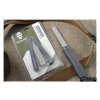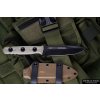Quality care as a necessary part for all knives????
No knife is designed to stand up to improper care. It is obvious, that you want to ensure that you’re doing everything you can to keep your tool in the best possible shape. By cleaning your knife and caring for it properly, you’ll extend its life and ensure optimal performance for many years to come.
Read through to know the ways through which one can maintain and take proper care of their knives.
1) Cleaning Your Fixed Blade Knife
When cleaning a fixed blade knife, it’s important to take care not to use harsh, abrasive cleaners. The stainless steel surface of your knife’s blade may be coated with DLC (Diamond Like Coating), ZrN (Zirconium Nitride), or it may simply be an uncoated CPM (Crucible Particle Metallurgy) S35VN steel or something similar. In either case, using a harsh cleaner could either remove the finish or damage the steel of your knife, and we don’t recommend it.
Instead, simply use a mild soap and warm water to clean your fixed blade knife. Also, be sure that you use something soft and non-abrasive for this task, such as a cotton cloth or the non-abrasive side of a sponge. Using an abrasive scouring pad, steel wool, or any other highly abrasive material will likely scratch the coating (or the uncoated stainless steel finish) of your knife.
For sticky or gummy substances (such as tree sap, tar, and so on), first use a cloth with acetone to remove the residue in question. Wipe the knife clean, and then be sure to follow the instructions below for oiling to protect the finish.
Once your knife has been cleaned, be sure to dry it thoroughly.
Don’t forget to exercise caution when handling your knife for cleaning.
Oiling Your Knife
2) After washing and thoroughly drying your knife, it’s time to oil the blade. Applying oil to your blade will help to disperse any remaining water and seal the blade from moisture, which will help to eliminate both unsightly water spots and any potential for rust. Using a chamois cloth, apply a small amount of oil such as WD-40 to your blade. This will serve to both protect your blade and give it a clean, shiny appearance.
How to Properly Store a Knife
3) If you’re carrying your knife with you on a daily basis, you’ll likely have it in a sheath of some kind on your person. If you own knives that you don’t use regularly, though, it’s important to store them properly once they’ve been cleaned.
When storing your knife, be sure to place it in a low humidity environment of some kind. If your knife is in a case, drawer, or cabinet, placing a dessicant of some kind (such as a silicone gel pack) next to the knife will help to ensure that moisture doesn’t settle onto the blade. Generally speaking, we also recommend oiling your knife a couple of times per year if it’s in long term storage and isn’t seeing regular use.
If you take care of you knife, it will serve you well for years to come.








